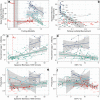Tipping point realized in cod fishery
- PMID: 34253825
- PMCID: PMC8275682
- DOI: 10.1038/s41598-021-93843-z
Tipping point realized in cod fishery
Abstract
Understanding tipping point dynamics in harvested ecosystems is of crucial importance for sustainable resource management because ignoring their existence imperils social-ecological systems that depend on them. Fisheries collapses provide the best known examples for realizing tipping points with catastrophic ecological, economic and social consequences. However, present-day fisheries management systems still largely ignore the potential of their resources to exhibit such abrupt changes towards irreversible low productive states. Using a combination of statistical changepoint analysis and stochastic cusp modelling, here we show that Western Baltic cod is beyond such a tipping point caused by unsustainable exploitation levels that failed to account for changing environmental conditions. Furthermore, climate change stabilizes a novel and likely irreversible low productivity state of this fish stock that is not adapted to a fast warming environment. We hence argue that ignorance of non-linear resource dynamics has caused the demise of an economically and culturally important social-ecological system which calls for better adaptation of fisheries systems to climate change.
© 2021. The Author(s).
Conflict of interest statement
The authors declare no competing interests.
Figures




References
-
- Myers R, Hutchings J, Barrowman N. Hypotheses for the decline of cod in the North Atlantic. Mar. Ecol. Prog. Ser. 1996;138:293–308. doi: 10.3354/meps138293. - DOI
-
- Levin PS, Möllmann C. Marine ecosystem regime shifts: Challenges and opportunities for ecosystem-based management. Philos. Trans. R. Soc. B Biol. Sci. 2015;370:20130275. doi: 10.1098/rstb.2013.0275. - DOI
Publication types
LinkOut - more resources
Full Text Sources

